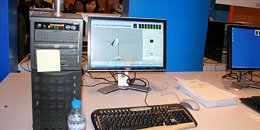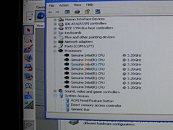Wednesday, April 2nd 2008

IDF 2008 Day 1: Intel Nehalem Working at 3.2GHz Pictured
I promissed more details on Intel Nehalem yesterday, and now it is time to keep my word. During the first day of Spring IDF 2008, the guys over at HEXUS.net have pictured the first working sample of a quad-core Intel Nehalem processor operating at 3.2GHz (revision A1). The 1366-pin, 731M-transistor 45nm native quad-core model, utilizes 256KB of L2 cache for each core, as well as 8MB of L3 cache. The CPU also integrates triple-channel DDR3-1333MHz memory controller and SSE4 instructions. Like the new 533MHz Silverthorne-based Atom processors, Nehalem will also incorporate Simultaneous Multithreading (SMT) which is also known as Hyper-Threading (HT). Each physical core in a single Nehalem processor is paired up with its own virtual core. As a result, the quad-core processor will be detected to have eight cores (on the picture). Predictions say that this new architecture will offer around 30% better performance, on a clock-for-clock basis, when compared to Core 2, in a heavily-multithreaded environment - HPC and low-end servers, mainly. Current Intel roadmaps list the Nehalem launch date for Q4 2008, with a simulteanous rollout across servers and desktops.
Sources:
HEXUS.net, DailyTech


31 Comments on IDF 2008 Day 1: Intel Nehalem Working at 3.2GHz Pictured
"Virtual" cores is worrying. It sounds like "Virtual PC". What happens is that you CAN have independent threads running, but IN PRACTICE... one execution stage of one thread is paused while the other is executed. Its acheived by having a DOUBLE SET of registers. But only 4 instructions can actually be executed at once, not 8. So a dual xeon quad core will be a lot faster (8 real cores) compared to the 4 real and 4 virtual cores. (the virtual cores only work when the real cores are not doing anything, e.g. waiting for memory).
The advantage of the virtual core is only for memory intensive loops where the execution part of the CPU is stalled waiting for memory lookups OUT OF CACHE. While the CPU is waiting for the memory... it can quickly do a couple of instructions on the "virtual thread".
The performance increase is going to be like P4 HT... but WORSE due to the fact that in most situations, one of the other 3 cores on the CPU will take the thread ownership.
P4 + HT compared to P4 without HT was approximately 20% gain IN THE BEST POSSIBLE (REAL WORLD)CIRCUMSTANCES and usually more like 1-2%.
So I agree withan earlier poster, its more of a marketing gimmick.
Whats needed is to see the Nehalem run a benchmark, e.g. CINEBENCH 10, and take a look at the CPU results. I think we will be disappointed. If not... they would have shown these results already.
anny way Nehalem is way more advanced then xeon or core2
i just cant wait for bloomfield :)
6 slots posible
trichannel 3 slots
dual 2 slots